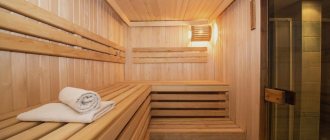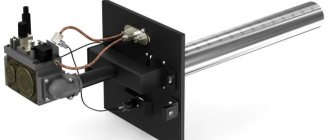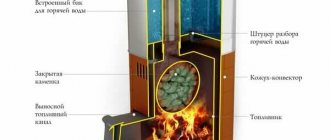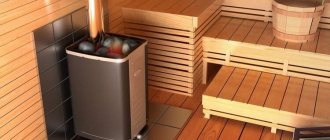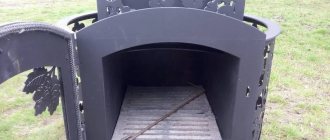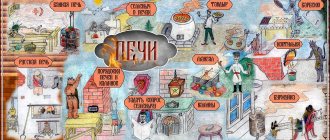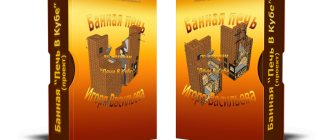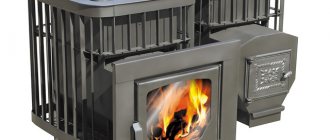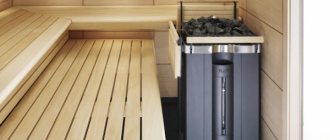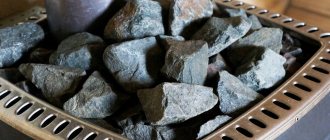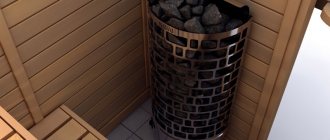Types of doors according to manufacturing method
Glass oven door made of heat-resistant material
Various materials are used to make oven doors: metal, cast iron, glass. Cast iron and metal structures have been used for a long time, heat-resistant glass is a new material.
Glass
Glass oven doors have been in use for the last 10 years. Glass sheets are manufactured in several versions:
- Single layer. They have a thickness of 3 mm and are used when burning wood, peat, and plant waste in a firebox.
- Multilayer, 4 mm thick. Installed during the combustion of coal with a high combustion temperature.
Transparent, frosted or embossed glass is installed in the stove doors. Glass doors make it possible to observe the flame. For transparency, you need to wipe the surface with soot-removing products, or buy a material with a coating that prevents its formation.
Metal
Homemade metal door
Ordinary ferrous metal will oxidize when exposed to moisture, this is especially true in a bathhouse. To prevent the formation of rust, metal doors are coated with heat-resistant paint.
The best, although more expensive, option is stainless steel. The product is light in weight and easily attached to a brick structure. The long service life pays off the high purchase price. The modern design makes this stove element a decoration for the interior of the room.
Cast iron
Cast iron construction for firebox and ash pan
A cast iron oven door is the best choice. Has the following advantages:
- durability, service life is practically unlimited;
- high heat resistance;
- wear resistance;
- versatility of use.
Cast iron products are used in furnaces that burn coal. The high temperature (up to 8000C) that occurs during combustion does not damage the structure. For the demanding consumer, a complex design of stove doors is developed and combined with glass inserts.
When casting cast iron products for the stove, complex technologies are used; decorating them with ornaments or decorative details complicates the process, making it expensive. Such models are not intended for mass use, but if you wish, you can always find a craftsman to make them.
Advantages and disadvantages
Cast iron oven doors have a number of advantages:
- They are made of material that can retain heat for a long time.
- The element prevents fire and smoke from entering the room.
- Resistant to high temperatures.
- Modern cast iron doors have a sophisticated appearance.
- Many models are equipped with special valves. With their help, you can regulate the flow of air into the combustion compartment.
The disadvantages of cast iron doors include their heavy weight. There may be difficulties during installation and use.
Groups of doors in the process of laying
Fire door
The stove design includes doors for various purposes. Each element has its own role. The following doors are separated:
- furnace;
- view;
- blowers;
- cleaning
Furnace
Designed for storing fuel. The combustion door performs the following functions:
- protection of the surrounding area from fire;
- heat transfer from material burning in the firebox to the room;
- preventing sparks from flying out;
- provides combustion with oxygen.
The material is chosen based on its practicality or the desire to decorate the interior of the room. The latest fashion trend is a stove door with glass.
Podduvalnaya
It is installed on the ash chamber, through which the oven is cleaned of ash that spills into the lower compartment. The blower door provides the process with air. By opening or closing it, the flow and rate of fuel combustion are regulated.
Blower doors are made of cast iron or steel, less often glass. They can be of a simple design, or they can be made of cast iron with a relief finish or ornament. They are made in the same style as fireboxes.
Cleaning
They close the hole in the chimney wall and serve to clean it from soot and soot. This is a necessary element in the design of the stove, ensuring its proper operation. Some builders ignore their installation, but an experienced stove builder will never do without cleanout holes. Their presence simplifies stove maintenance and smoke-free operation.
View
To prevent hot air from leaving the stove after combustion of fuel, a damper is installed on the chimney. It is a frame with grooves along which a plate moves, blocking the smoke exhaust channel. The valve is placed in the brickwork of the pipe.
One type of gate valve is a view. This is a frame with a hole, sides and two covers, located inside the chimney. This double protection ensures tight blocking of heat escape. A view valve is installed on the channel wall; it is usually made of cast iron.
Cleaning
Blower View
Classification of doors for stoves and fireplaces
Despite the fact that stove doors are quite simple in their design, nevertheless, doors for stoves and fireplaces are very diverse and differ in purpose, materials of manufacture, sizes and other operational characteristics. The main requirement for all types of stove doors is to ensure fire safety during operation of the heating structure. All materials from which the oven door is made must have a high level of strength and fire resistance. The manufactured door must provide fire safety and be able to withstand the effects of high temperatures.
Fire doors
Fire doors - designed for access to the furnace firebox, for storing fuel: firewood, coal, etc. It should be understood that fire doors must have a certain level of tightness in order to regulate the supply of oxygen to the combustion chamber. A high-quality door is one that is capable of regulating the supply of oxygen to the furnace or preventing the entry of uncontrolled air flows into the firebox. This makes it possible to influence the speed and efficiency of fuel combustion, regulate the amount of fuel burned and use it more efficiently.
According to this principle, furnace doors are divided into:
- Leaky;
- Compacted;
- Sealed.
Sealed oven door with glass
Sealed blind oven door
Leaky blind oven door
Sealed doors have design features: an insulating heat-resistant cord and a clamping mechanism, due to which the door fits tightly to the stove and prevents the uncontrolled flow of oxygen into the furnace firebox, that is, it makes it possible to adjust the flame and fuel combustion rate. The efficiency of ovens with a sealed door is higher. Sealed combustion doors make it possible to obtain more heat and reduce the amount of fuel consumed.
Sealed oven doors also provide a certain level of tightness. They differ from sealed ones in the absence of a heat-resistant cord, while a pressing and locking mechanism is also used.
Unsealed - ordinary classic oven doors that have a simple locking mechanism - a handle that closes the door by rotating around its axis.
Oven doors with or without glass
Fire doors are also usually divided according to the presence or absence of glass.
Fireplace oven doors with glass are equipped with heat-resistant glass that can withstand high temperatures. Such doors allow you to look at the fire and create an atmosphere of comfort and coziness. But stove doors with glass also have a number of disadvantages:
- The efficiency and efficiency of a stove with a door with glass is lower, since part of the heat generated during fuel combustion is dissipated through the glass rather than transferred to the heat storage elements of the stove. At the same time, the larger the glass size of the oven door, the more efficiency decreases.
- Also, a stove with a door with glass must have design features that ensure hot air flows over the glass, otherwise soot will constantly settle on the glass of the combustion door, and the smoked glass will constantly require cleaning.
Oven doors without glass are usually called solid or blind.
Furnace portal with glass
Blower oven door
Cleaning oven door
Blower oven doors
Blower doors
are designed for access to the ash chamber (ash chamber) for removing ash, as well as for adjusting the air supply to the furnace firebox through the grate.
Blower doors , depending on the ability to ensure tightness, just like furnace doors, are divided into sealed, sealed and non-sealed. Hermetically sealed blower oven doors have a pressing mechanism and a heat-resistant cord. The sealed ones have either a clamping mechanism or a heat-insulating cord, providing a certain level of tightness.
Leaky blower doors are ordinary, usually inexpensive doors with a simple locking device that does not provide a tight seal.
Both combustion and ash doors can be equipped with a system for adjusting combustion modes and a damper. The stove door slide allows you to adjust the fire level in the stove firebox. It is enough to open the damper slightly to supply air into the firebox, and there is no need to open the door itself.
Furnace portals
Furnace portals are a design that combines a combustion chamber and a furnace door. The stove portal not only decorates the front of the stove, but also removes part of the heat load, increasing the durability of the stove. The stove portal also simplifies the construction of a stove or its repair.
Cleaning oven doors
Cleaning doors
designed for access to the smoke ducts of the furnace. Brick heating stoves, as a rule, have channels through which streams of hot air move, and the stove is heated before entering the chimney. Cleaning doors are installed at the turning points of the furnace channels to periodically remove ash and soot that settle on the surface of the channels. Often, in order to save money, stove makers dispense with the use of cleaning doors and leave a embedded, marked brick in the masonry, which, if necessary, is pulled out to clean the stove channels. Of course, the use of cleaning doors makes the cleaning process much more convenient.
Cast iron or steel oven doors?
Another important feature of the stove door is the material it is made of. Basically, in addition to glass, cast iron or heat-resistant steel are used to make stove doors.
Cast iron stove doors are durable, since cast iron is stronger and more resistant to high temperatures than steel. But cast iron is much heavier, and it is not always possible to make a door of a special shape or design from cast iron. The production of cast iron products requires foundry production facilities. Cast iron products cannot be produced by small businesses or in artisanal production conditions.
Steel doors are still strong enough and heat-resistant for their purposes. In addition, it is easier to make a door for a stove or fireplace from steel of almost any shape, even an exotic one.
Both cast iron and steel oven doors are quite durable and reliable. It’s up to you to decide which stove doors to buy.
Types depending on the stove design
The sealed door has a heat-resistant cord around the perimeter
If you need a door for the oven, you should pay attention to its design. They may be leak-proof, sealed, or sealed.
Ordinary doors
This is a regular classic model with a rotary handle that secures the door from opening. Installed in simple brick stoves in old village houses. It is not airtight. Such a design may have a mechanism that presses it tightly to the hearth.
The doors are sealed
Oven doors with glass can be sealed. To seal the gap, an insulating cord made of heat-resistant material is laid around the perimeter. A tightly closed door promotes strong combustion, a high rate of fuel combustion and rapid heating of the room. Sealed doors prevent the penetration of combustion products into the surrounding room and air pollution.
What are they?
Fire doors can be of various sizes, shapes and configurations. They fall into two main categories:
- Models with a “blind” configuration. They have a solid surface, which is often decorated with various patterns.
- Glass stove doors. Their main difference is the presence of heat-resistant panoramic glass, through which you can control the combustion process, as well as observe the peaceful smoldering of the firewood.
Structurally, stove doors consist of a base frame, doors, spark protection, heat-resistant glass (in glass fireplace doors), a slide damper, hinges and handles.
Primary requirements
Cast iron door can withstand temperatures up to 8000 degrees
The main purpose of the stove door is to ensure fire safety of the home. It prevents flames and sparks from escaping, coals falling out of the fireplace, protects the room from smoke, and speeds up the process of ignition and combustion of fuel. The door material is selected depending on the heating oil used.
The glass must be at least 4 mm thick; it can withstand temperatures up to 6000C. Used for stoves and fireplaces heated with wood. In this case, metal doors are also used. When burning coal, coke or mixed fuel in a furnace, cast iron doors must be installed; temperatures up to 8000C are permissible for them.
How to make a door with your own hands
The first step is to measure the dimensions of the door - the height and width of the stove opening in which it will be installed. To do this, use a tape measure and a marker. If you want to make an arched door, determine the height in the center and two side dimensions. It is necessary to make a drawing on paper to make it easier to manufacture the product.
First, a metal frame is made from corners to fit the size of the stove opening. The door may have a fireproof glass insert, or it may be closed with a sheet of metal. The glass is attached to the frame with bolts; they are not clamped too tightly so as not to interfere with expansion when heated.
The simplest door is a solid metal one. A metal plate is welded to the frame, which tightly closes the hole.
Cast iron doors are difficult to make, so this is not done at home.
A handle and curtains are welded to the structure and painted with heat-resistant paint. Install the door using bolts or anchors.

